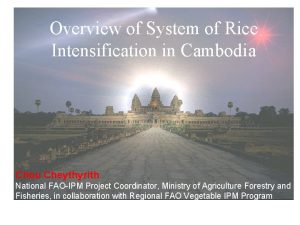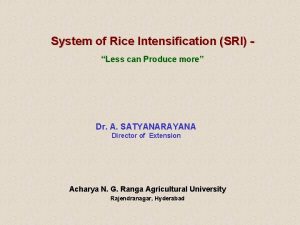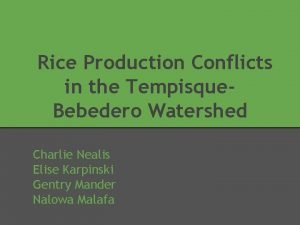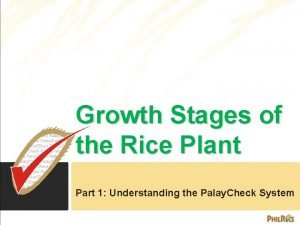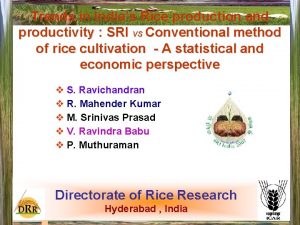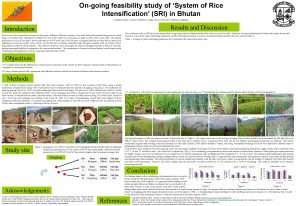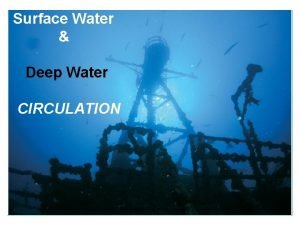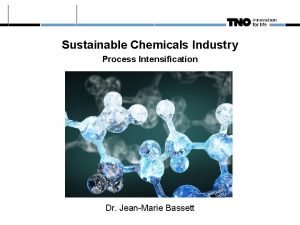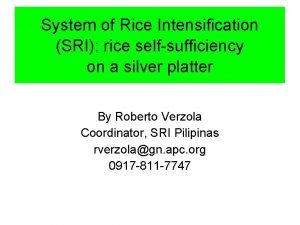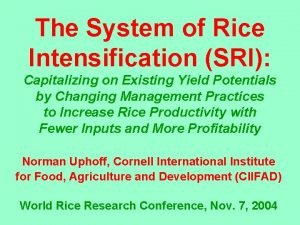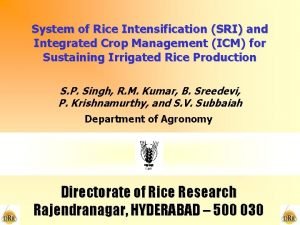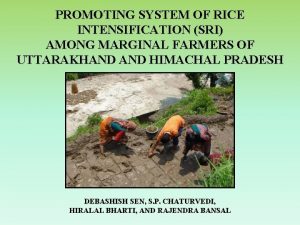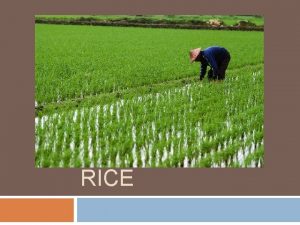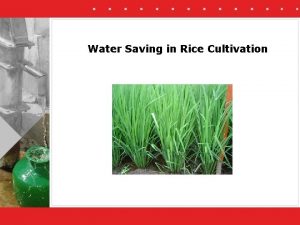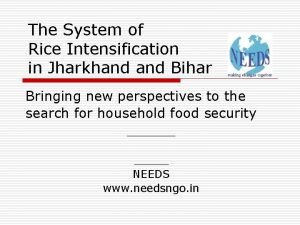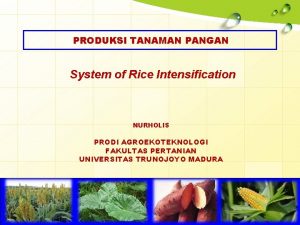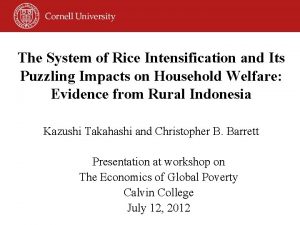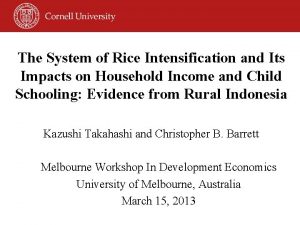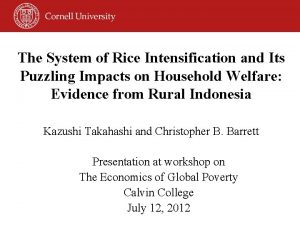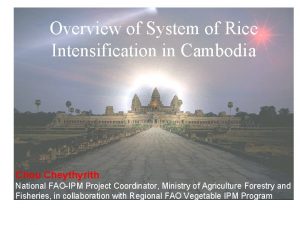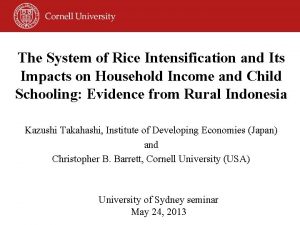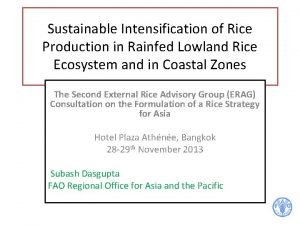System of Rice Intensification SRI Technical Presentation The





































- Slides: 37

System of Rice Intensification (SRI) Technical Presentation

The Evolution of SRI

SRI was first developed with irrigated rice, where farmers had complete control over when and how much they watered their plots

Under these ideal conditions, SRI had 6 original practices: 1. Fertilize primarily with organic matter 2. Transplant at the 2 -leaf stage – 8 -12 days 3. Use wide spacing – 25 cm x 25 cm or more, in a square grid pattern 4. Only 1 plant per ‘hill’ 5. Keep soil aerobic during the vegetative growth phase* 6. Use a rotary weeder to control weeds and aerate the soil *The vegetative growth phase covers the period up until plants start flowering

The 6 original SRI practices: 1. Use organic matter 2. Transplant at the 2 -leaf stage 3. ≥ 25 x 25 cm spacing, in a grid 4. One plant per ‘hill’ 5. Keep soils aerobic 6. Use a rotary weeder

Synergy These 6 practices combine to induce a synergistic change in how rice plants grow, and the shape/form they take. This change allows each plant to be more productive, regardless of what variety of rice is used.

Because the change is synergistic, doing only some of the 6 practices doesn’t yield the same impact. For example: • • Wide spacing without early transplanting results in less tillering, more empty space between plants, and more weed competition Early transplanting without wide spacing leaves plants little room to produce more tillers

One important aspect of SRI is how it helps plants take better advantage of their own natural ability to produce more tillers. transplanting time Late transplanting # of tillers Early transplanting (with SRI) transplanting time Each plant has a relatively fixed window for vegetative growth, and tiller production follows an s-curve, so any delay in starting greatly reduces overall potential.

Under SRI, a rice field will have far fewer plants (80 -95% fewer), each with a far greater number of tillers. Each of these larger plants is also healthier, stronger, and more resilient against pests, diseases, and severe weather, and there is better airflow and circulation between the plants.

As SRI spread, farmers began adapting it to rice fields that weren’t irrigated, testing how to get this synergy without the same water control.

Farmers found that SRI works in different settings, as long as you follow four basic principles underlying the original 6 practices. 1. Establish plants early and carefully 2. Reduce plant density 3. Build soil health and fertility using organic matter 4. Manage water carefully to avoid permanent flooding during the vegetative growth phase

For each of these four principles, farmers are free to follow practices that work best with their local conditions. • • The goal is to have the same type of results as with SRI for irrigated rice: improve plant/soil health and increase yields, while using less water and seed, and fewer agrochemical inputs. For each farmer and under each different set of conditions, how this is practiced may look different

Farmers have also experimented with using SRI methods on other crops SCI, or the System of Crop Intensification, has been shown to work well with maize, wheat, sugar cane, tef, finger millet, turmeric, potatoes, mustard, legumes, sesame, tomatoes, green leafy vegetables, and other crops.

Adapting SRI to different conditions

Let’s take a closer look at how farmers can adapt each of these four principles.

Principle 1: Establish plants early and carefully

Principle 1: Establish plants early and carefully Example practices farmers can choose from include: • Practices any farmer can use: – Select only the healthiest and largest seeds – Soak and germinate seeds prior to sowing • For farmers using a nursery and transplanting: – Carefully prepare a raised bed nursery, and sow seeds with extra space – Transplant carefully at the two-leaf stage

Principle 2: Reduce plant density

Principle 2: Reduce plant density Example practices farmers can choose from include: • Practices any farmer can use: – Use 25 cm by 25 cm spacing (or more), in a grid • For farmers using a nursery and transplanting: – Use only 1 plant per hill – Transplant carefully at the 2 -leaf stage • For farmers sowing directly into their field: – Use only 1 -2 plants per hill, or line seed and thin at the 2 -leaf stage to mimic an SRI grid

Principle 3: Build soil health and fertility using organic matter

Principle 3: Build soil health and fertility using organic matter Example practices farmers can choose from include: • Practices any farmer can use: – Fertilize with organic matter, using synthetic/chemical fertilizers only in a supplementary manner (or not at all, if organic) – Combine SRI with other agroecological methods, such as Conservation Agriculture, agroforestry, permaculture, Ever. Green Agriculture, etc.

Principle 4: Manage water carefully to avoid permanent flooding during the vegetative growth phase

Principle 4: Manage water carefully to avoid permanent flooding during the vegetative growth phase Example practices farmers can choose from include: • Practices any farmer can use: – Incorporate organic matter into the soil to retain healthy soil moisture/oxygen levels – Use leveling and bunding to retain runoff/ prevent flooding • Practices some farmers may be able to use: – Change the rice cropping season to prevent flooding during the vegetative growth phase

Understanding how SRI changes for different rice systems

Rice can grow in nearly every climate zone in West Africa, from the Sahel in the north to the humid coastline in the south.

There are 4 major rice systems in the region: 1. Irrigated rice occurs in every climate zone, as long as there is enough water, and the right infrastructure exists 2. Rainfed upland rice occurs in the southern and middle latitudes, where rainfall is sufficient to grow rice in a manner similar to maize 3. Rainfed lowland rice occurs in valleys and ponds that flood seasonally throughout West Africa 4. Swamp/deepwater rice occurs in the coastal southwest, using special varieties of rice

1. Irrigated rice is perfect for using SRI, as there is great control over water, allowing farmers to keep their fields aerobic during the vegetative growth phase, and to water easily when they need to.

2. Rainfed upland rice With rainfed upland rice there is little if any risk of flooding, making aerobic soil management easy, but unpredictable rainfall makes nursery timing difficult with SRI, so many farmers choose to sow their rice directly instead.

2. Rainfed upland rice (cont. ) Farmers can sow directly by hand, at 2 seeds per hill, and then thin at the 2 -leaf stage, leaving only 1 seedling per hill. Or farmers can sow in lines with SRI spacing between rows (1), using a machine, and come back at the 2 -leaf stage (2) to thin plants with a machine or hoe (3) in order to achieve the SRI grid and spacing within rows (4): 1. 2. 3. 4.

2. Rainfed upland rice (cont. ) Leveling and bunding fields helps prevent erosion and lets rainwater slowly percolate into the soil. Organic matter helps the soil retain moisture and attracts earthworms and other organisms that can help improve soil structure and infiltration.

3. Rainfed lowland rice is the most variable system, and can be more challenging for SRI since fields typically flood seasonally. Mid-slope fields may be less prone to permanent flooding. Most farmers can level their fields and build bunds to partially manage water, or plant earlier to avoid flooding.

3. Rainfed lowland rice (cont. ) Leveling and bunding helps farmers better control water, whether to keep water in or out of their plots. Organic matter helps the soil retain moisture and attracts earthworms and other organisms that can help improve soil structure and improve infiltration.

3. Rainfed lowland rice (cont. ) Elevation along the slope relevant to flooding influences how easy it is to do SRI in some rainfed lowland areas. A PCV trial in Senegal showed yields were highest for SRI in the middle zones, where natural flooding was intermittent. 2. 070 t/ha 3. 195 t/ha 2. 530 t/ha Above flood zone Flooding for 1 -2 days after each rain Source: Perricone-Dazzo, L. 2014. Farmer Centered Research on Improved Rice Cropping Systems in the Peanut Basin of Senegal: Peace Corps System of Rice Intensification Extension Campaign. Cornell University MPS Project Paper. Permanent flooding, or for 1 -2 weeks after each rain

3. Rainfed lowland rice (cont. ) In other areas, water levels may rise seasonally and stay flooded continuously for several months. In places like this it may be possible to practice SRI by timing the planting so that the vegetative growth phase ends around the time the fields start flooding. Below is an example. January December Traditional rice season timing Possible SRI timing Period of vegetative growth phase Period of flooding

4. Swamp/deepwater rice Swamp and mangrove rice is not well suited for SRI, and little if any experimentation has been done to date on adapting SRI to swamp/deepwater rice, since flooding is typically unavoidable.

Summary

Summary • SRI started with irrigated rice, using 6 practices • These were adapted for rainfed fields • 4 broad principles cover both irrigated and rainfed SRI • The goal is the same: create synergy to enhance plant and soil health, and increase yields while decreasing use of inputs, seed, and water • In rainfed upland fields, farmers can sow directly and use leveling, bunding, and organic matter to help regulate water more effectively • In rainfed lowland fields, farmers can use leveling, bunding, and organic matter to help regulate water more effectively, and in some cases SRI will be more effective in mid-slope areas or when started earlier than normal • SRI can be used for other crops as well (SCI)
 Sri system of rice intensification
Sri system of rice intensification Sri system of rice intensification
Sri system of rice intensification Sri system of rice intensification
Sri system of rice intensification Growth stages of rice plant
Growth stages of rice plant Sri system of rice intensification
Sri system of rice intensification Sri rama sri rama sri manoharama
Sri rama sri rama sri manoharama System of rice intensification
System of rice intensification Rapid intensification
Rapid intensification Western intensification
Western intensification Process intensification example
Process intensification example Payment and settlement system in sri lanka
Payment and settlement system in sri lanka Lanka settle system
Lanka settle system Payment and settlement system in sri lanka
Payment and settlement system in sri lanka Sri lanka tsunami warning system
Sri lanka tsunami warning system Technical communication powerpoint presentation
Technical communication powerpoint presentation مقدمة عن الرسم الفني
مقدمة عن الرسم الفني Hát kết hợp bộ gõ cơ thể
Hát kết hợp bộ gõ cơ thể Bổ thể
Bổ thể Tỉ lệ cơ thể trẻ em
Tỉ lệ cơ thể trẻ em Chó sói
Chó sói Chụp phim tư thế worms-breton
Chụp phim tư thế worms-breton Hát lên người ơi alleluia
Hát lên người ơi alleluia Kể tên các môn thể thao
Kể tên các môn thể thao Thế nào là hệ số cao nhất
Thế nào là hệ số cao nhất Các châu lục và đại dương trên thế giới
Các châu lục và đại dương trên thế giới Công thức tính thế năng
Công thức tính thế năng Trời xanh đây là của chúng ta thể thơ
Trời xanh đây là của chúng ta thể thơ Mật thư tọa độ 5x5
Mật thư tọa độ 5x5 Làm thế nào để 102-1=99
Làm thế nào để 102-1=99 Phản ứng thế ankan
Phản ứng thế ankan Các châu lục và đại dương trên thế giới
Các châu lục và đại dương trên thế giới Thơ thất ngôn tứ tuyệt đường luật
Thơ thất ngôn tứ tuyệt đường luật Quá trình desamine hóa có thể tạo ra
Quá trình desamine hóa có thể tạo ra Một số thể thơ truyền thống
Một số thể thơ truyền thống Cái miệng nó xinh thế chỉ nói điều hay thôi
Cái miệng nó xinh thế chỉ nói điều hay thôi Vẽ hình chiếu vuông góc của vật thể sau
Vẽ hình chiếu vuông góc của vật thể sau Biện pháp chống mỏi cơ
Biện pháp chống mỏi cơ
